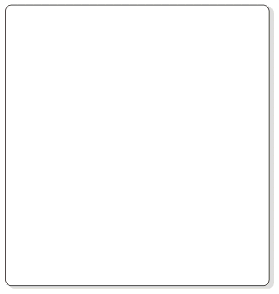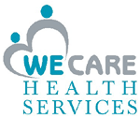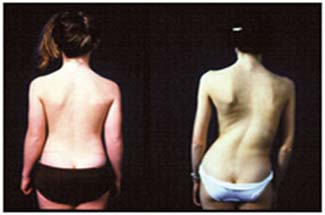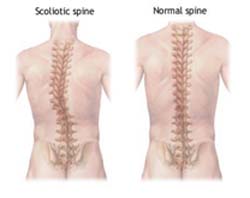



Scoliosis India offers information on Scoliosis in India, Scoliosis cost India, Scoliosis hospital in India, Delhi, Mumbai, Chennai, Hyderabad & Bangalore, Scoliosis Surgeon in India
What is Scoliosis?
Anatomy of Scoliosis
Causes of Scoliosis
Symptoms of Scoliosis
Diagnosis of Scoliosis
Treatments for Scoliosis
What is Scoliosis?

Some degree of scoliosis may occur in severe osteoarthritis patient. It is a spinal curvature as seen from the front or back of the person who has it. Instead of being straight shape, spine assume an‘s’ or ‘c’ shape. The curves are measured in degrees. Curve which is more than 30 degree need to be carefully watched because they can worsen rapidly. Scoliosis more often then seen with osteoarthritis person as compared to general population.

Anatomy of Scoliosis
Scoliosis is an abnormal side to side curvature of the spine. A normal spine will have curves that run from front to back. When viewed from the back, a normal spine will appear perfectly straight. When viewed from the back, a spine with scoliosis will appear to curve to one side, or both. This condition can also cause the rotation of individual vertebra in the spine.
The curvature of the spine is measured in degrees, just like an angle. A normal spine is straight, or has a curve less than 10 degrees. Mild curvature is from 10 to 20 degrees. Moderate curvature is 20 to 50 degrees. Severe spinal curvature is measured at over 50 degrees.
Causes of Scoliosis
Nearly 80-85% of scoliosis are Idiopathic, which means the cause cannot be identified. Causes of scoliosis may be structural or functional. There are some few known causes of scoliosis which include birth defects, tumors and injury.
Causes of Functional Scoliosis
When the spine is structuring normal but it appears curved because of another cause is called as functional scoliosis. Such type of scoliosis is often caused by underlying condition such as 1) If there is difference in length of leg 2) Muscle spasms or 3) Inflammatory condition such as appendicitis
Causes of Structual Scoliosis
The spine curvature is abnormal in structural scoliosis. It may be due to unknown factors Birth defects, Injury, Certain Infections, Tumors, Rheumatic disease, Neuromuscular disease(such as polio, muscular dystrophy and cerebral palsy) or Connective tissue disorders
Causes of Structual Scoliosis
The spine curvature is abnormal in structural scoliosis. It may be due to unknown factors Birth defects, Injury, Certain Infections, Tumors, Rheumatic disease, Neuromuscular disease(such as polio, muscular dystrophy and cerebral palsy) or Connective tissue disorders
Symptoms of Scoliosis
Scoliosis is usually painless. Scoliosis usually doesn't cause pain or limit a child's movements, so it is easily overlooked. Most children receive a diagnosis during a routine physical.
Still, alert parents can often spot early warning signs :
Diagnosis of Scoliosis
As always, a careful history and physical examination are the first steps in diagnosis of scoliosis. The diagnosis of scoliosis is often made on physical examination.
An X ray of the back will show exactly where and how much the spine is curved. The doctor can make very precise calculations from the X-ray photograph to determine a measurement known as the Cobb angle. The Cobb angle combines all of the data provided by an X-ray photograph to determine the extent of a person's scoliosis. Occasionally, magnetic resonance imaging (MRI) would be done.
Treatments for Scoliosis
Non - Surgical Treatment of Scoliosis
The non-operative treatment of scoliosis involves observing the deformity with examinations and repeated x-rays. Under certain Circumstances, when spinal growth remains, a brace may be used in combination with follow-up x-rays. Physical therapy exercises have not been shown to be effective treatment for scoliosis.
Surgical Treatment of Scoliosis
The most common surgical treatment for scoliosis is a Spine Fusion using special stainless steel rods, hooks, and a bone graft. The rods are attached to the spine with hooks and the curved portion of the spine is carefully straightened. Then, small strips of bone graft are placed over the spine to fuse it in a straight position.
As the bone graft heals over the next several months, the spine becomes solid and will not curve again. But the part of the spine that has not been fused will still be flexible, and allow nearly normal overall movement.
Scoliosis Treatment, Scoliosis Surgery India, Scoliosis Surgery, Back Braces, Observation, TLSO, Charleston Bending, Adolescent Scoliosis, Idiopathic Scoliosis, India Hospital Tour, Scoliosis, Scoliosis Surgery, Lumbar, Thoracic, Idiopathic, Surgery, Complications, Diseases And Conditions, Cost Scoliosis Surgery India, Less Price Scoliosis Surgery India to Low Cost Scoliosis Surgery India, Rheumatoid Arthritis, Pain Relief, Joint Pain, Hospitals And Clinic, Low Cost Scoliosis Surgery India